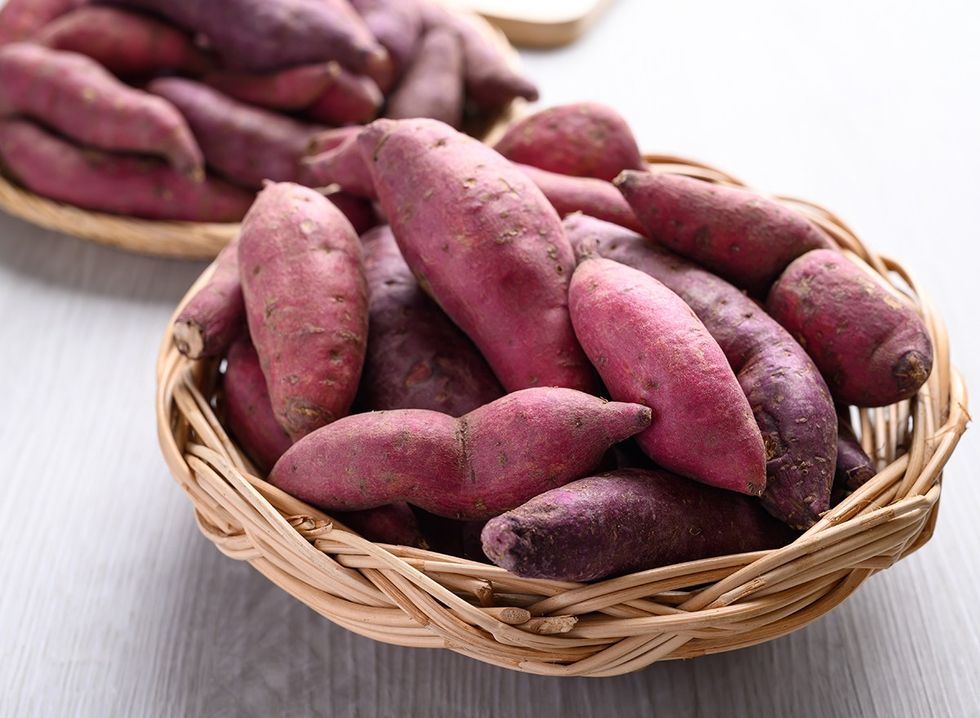The Blue Zones, which are Ikaria, Greece, Loma Linda, California, Sardinia, Italy, Nicoya, Costa Rica, and Okinawa, Japan, are famous for having people who live healthy lives up to and beyond 100. The diet these communities enjoy is a major factor for their longevity and vitality. “The blue zone eating pattern is 98% plant-based foods — whole food-based and high carbohydrate. But only complex carbs, not the simple carbs like salty snacks and candy bars and soda pop,” Dan Buettner told CNN. “You say carbohydrates and people are horrified, but the healthiest foods in our food system are complex carbohydrates.” Here are 11 foods blue zones dieters love for their incredible longevity benefits.
RELATED: The Best Longevity Tips From the “Blue Zones”.
1. Purple Sweet Potato
Shutterstock
Purple sweet potatoes are not only delicious but a nutritional powerhouse, packed with Vitamins A, C, and E, B vitamins, and potassium, at just 1.5 calories per gram and 220 calories per cup. “The dietary intake of Okinawans until 1975 came from purple sweet potatoes,” Buettner said. “I would argue it produced the longest-lived population in the history of humankind.”
2. Nuts

Nuts are a big part of the blue zones diet. “A handful of nuts weighs about two ounces, the average amount that blue zones centenarians consume—almonds in Ikaria and Sardinia, pistachios in Nicoya, and all nuts with the Adventists,” according to bluezones.com. “The Adventist Health Study 2 found that nut eaters outlive non–nut eaters by an average of two to three years.”
3. Sourdough and Whole Wheat Bread
Shutterstock
People in the blue zones do not eat over-processed supermarket bread. Instead, they enjoy delicious sourdough and whole wheat options. “Bread from the blue zones is either whole grain or sourdough, each with its own healthful characteristics,” according to bluezones.com. “In Ikaria and Sardinia, breads are made from a variety of whole grains such as wheat, rye, or barley, each of which offers a wide spectrum of nutrients, such as tryptophan, an amino acid, and the minerals selenium and magnesium. Whole grains also have higher levels of fiber than most commonly used wheat flours.”
4. Beans

Buettner says beans are a cornerstone of the diet. “I tried to be very precise, looking at the data, to find exactly what people in the blue zones ate,” Buettner said. “The five pillars of every longevity diet, including the blue zone, are whole grains, vegetables in season, tubers, nuts and beans. In fact, I argue the cornerstone of a longevity diet is beans.”
5. Leafy Greens
Shutterstock
People in the blue zones eat a variety of leafy green vegetables. Researchers found that diets rich in cruciferous vegetables help slow down the aging process. “What is extremely exciting is that food and lifestyle practices, including specific nutrients and food compounds known to selectively alter DNA methylation, are able to have such an impact on those DNA methylation patterns we know predict aging and age-related disease,” Dr Kara Fitzgerald told the journal Aging.
6. Tea

Tea is a staple of the blue zones diet—both regular and herbal. “People in all the blue zones drink tea. Okinawans nurse green tea all day. Green tea has been shown to lower the risk of heart disease and several cancers. Ikarians drink brews of rosemary, wild sage, and dandelion—all herbs known to have anti-inflammatory properties.”
7. Goat and Sheep Milk

Buettner says people in Blue Zones avoid red meat and cow’s milk. “People in blue zones don’t eat nearly as much fish as the Mediterranean diet prescribes, only three times a week and only 3 ounces,” he told CNN. “Meat is eaten only five times a month. There’s no cow’s milk in any blue zone.” The only place where cow’s milk is used is in the U.S. Adventist community.
8. Coffee

The Sardinians, Ikarians, and Nicoyans all drink plenty of coffee. Whether caffeinated or not, coffee is linked to a longer lifespan. “Caffeine is the most well-known constituent in coffee, but the beverage contains more than 100 biologically active components,” says Professor Peter Kistlerof the Baker Heart and Diabetes Research Institute, Melbourne, Australia. “It is likely that the non-caffeinated compounds were responsible for the positive relationships observed between coffee drinking, cardiovascular disease and survival. Our findings indicate that drinking modest amounts of coffee of all types should not be discouraged but can be enjoyed as a heart healthy behavior.”
RELATED: Longest-Living Family Reveals Their Diet.
9. Red Wine

Red wine (in moderation) is linked to many health benefits. “Sardinians are famous for their daily consumption of the robust, regional red wine called Cannonau,” according to bluezones.com. “Cannonau wine has two to three times the level of artery-scrubbing flavonoids as other wines. Small doses of this antioxidant-rich beverage throughout the day could explain fewer heart attacks and lower levels of stress among men in this region of the world.”
10. Fruit
Shutterstock
Fruit is a major part of the blue zones diet. “In a study out of Taiwan, researchers concluded that spending just 50 cents a day on fruits or vegetables could buy people about a 10% drop in mortality,” says Michael Greger MD, FACLM, via NutritionFacts. “That’s quite a bargain. Imagine if there was a drug that—without side-effects—could lower our risk of death 10%. How much do you think drug companies would charge? Probably more than 50 cents.”
11. Water

No, not drinking water (which they do!) but living near water seems to have a significant impact on health and happiness. “When you take worldwide data on happiness, and you control for everything else, you find that people who live next to water are…happier than people who [don’t],” Buettner tells CNBC Make It. “It may be the tranquilizing effect of water or it may be that the climate is moderated because of the water, but it seems to make us happier.”




